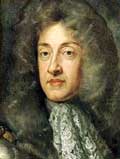 |
James VII
b. 14/24 Oct 1633, London, England
d. 5/16 Sep 1701, Château St. Germain-en-Laye, France [1] |
| Title: |
Dei gratia Scotie Anglie Francie et Hibernie Rex, Fidei Defensor, etc. = By the grace of God, King of Scotland, England, France and Ireland, Defender of the Faith, etc. (see other style in non-statutory use) |
| Term: |
6/16 Feb 1685 - 11/21 Apr 1689 |
|
6/16 Feb 1685, succeeded to the throne (proclaimed 10/20 Feb 1685 in Edinburgh) |
|
23 Dec 1688/2 Jan 1689, ceased to exercise royal authority upon leaving the British Isles [2] |
|
11/21 Apr 1689, declared to have forfeited the throne of Scotland in "An Instrument of Government, for Settling the Crown and Regal Dignity of the Kingdom of Scotland Upon William III and Mary II, King and Queen of England, &c.", passed by the Convention of the Estates of Scotland, meeting of the Convention, Edinburgh [3] |
| Names/titles: |
Baptised (24 Nov/3 Dec 1633): James; private name: James Stuart; Gaelic name: Seumas; |
|
Duke of York [27 Jan/6 Feb 1644 - 6/16 Feb 1685]; Earl of Ulster [10/20 May 1659 - 6/16 Feb 1685]; duc de Normandie [31 Dec 1660/10 Jan 1661 - 6/16 Feb 1685]; Duke of Albany [31 Dec 1660/10 Jan 1661 - 6/16 Feb 1685] |
|
Dei gratia Anglie Scotie Francie et Hibernie Rex, Fidei Defensor, etc. = By the grace of God, King of England, Scotland, France and Ireland, Defender of the Faith, etc. as James II [6/16 Feb 1685 - 12/22 Feb 1689] |
| Biography: |
| Second eldest surviving son of Charles I and Henrietta Maria of France; was named Lord High Admiral of England (1638); escaped to the Continent in April 1648 during the Civil Wars; held the office of Governor of Jersey (1650); served in the French and Spanish armies; was made Lord High Admiral (1660-1673, 1685-1689) upon the restoration of the Stuarts; fought in the Battle of Lowestoft, where his fleet completely defeated the Dutch (1665); reconciled to the Roman Catholic Church (1670); was compelled to resign all state offices, refusing to receive communion according to the rites of the Church of England as required by the Test Acts (1673); after the death of his first wife, Anne Hyde, married a Roman Catholic princess, Mary Beatrice Eleanora Anne Margaret Isabella d'Este of Modena (20/30 Sep 1673 by proxy, 21 Nov/1 Dec 1673 in person); succeeded his brother Charles II as King of England and Scotland although the House of Commons attempted to prevent his accession to the throne of England; harshly suppressed the revolt of his nephew, James Scott Duke of Monmouth and of Buccleuch, a claimant to the English and Scottish crowns (1685); alienated many supporters by holding a series of repressive trials, the Bloody Assizes (1685); began asserting the dominance of the Roman Catholics by appointing them to key offices; passed the Declaration of Indulgence (1687) aimed at establishing freedom of religion in England, but failed to achieve a compromise with the Protestant majority; was forced to flee from the British Isles after the Protestant leaders invited James' son-in-law, the Prince of Orange (later William III [William II in Scotland]), to invade England; following the landing of William at Torbay, Devonshire (5/15 Nov 1688), fled from London but was intercepted in Kent; was allowed to leave the English soil (23 Dec 1688); declared to have abdicated the Government of England (12/22 Feb 1689) by the Convenion Parliament; forfeited the throne of Scotland (11/21 Apr 1689) as declared by the Estates of Scotland, while William III and Mary II were declared joint sovereigns in England and Scotland; aided by King Louis XIV, landed in the harbor of Kinsale, County Cork, Ireland (12/22 Mar 1690), in an attempt to regain his thrones; presided at the opening of Parliament in Dublin (7/17 May 1690); was defeated in the Battle of the Boyne (1/11 Jul 1690); boarded a French ship (2/12 Jul 1690) which took him to Kinsale and from there he took a ship for France and lifelong exile. |
| Biographical sources: "James II", by Francis C. Turner (London: Eyre and Spottiswoode, 1948). |
| |
| [1] |
An assertion found in many sources that James II/VII died 6/17 Sep 1701 may result from a miscalculation done by an author of anonymous "An Exact Account of the Sickness and Death of the Late King James II, as also of the Proceedings at St. Germains thereupon, 1701, in a letter from an English gentleman in France to his friend in London" (Somers Tracts, ed. 1809-1815, XI, pp. 339-342). The account reads: "And on Friday the 17th instant, about three in the afternoon, the king died, the day he always fasted in memory of our blessed Saviour's passion, the day he ever desired to die on, and the ninth hour, according to the Jewish account, when our Saviour was crucified." As 17 Sep 1701 New (Gregorian) Style falls on a Saturday and the author insists that James died on Friday, "the day he ever desired to die on", it might be concluded that the author miscalculated the date which later made it to various reference works. See English Historical Documents 1660-1714, ?:136-138. |
| [2] |
History of the Desertion, 105. |
| [3] |
Proceedings of the Estates in Scotland 1689-1690, 1:35. |
|
Image: portrait of James II by Sir Godfrey Kneller, c. 1685. |

